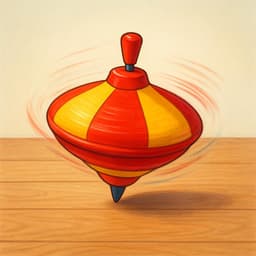Gira la jirafa gigante.
JI-ra la ji-RA-fa ji-GAN-te
The giant giraffe spins.
🔊 Listen & Practice
Start with slow speed to master pronunciation, then gradually increase to challenge yourself.
🎨 Visualization

Gira la jirafa gigante. A giant giraffe that spins!
🎯 Pronunciation Focus
The Spanish 'j' Sound (soft 'g')
/x/This sound, made by 'g' before 'i' or 'e' (and also by the letter 'j'), comes from the back of your throat. It's similar to the 'h' in 'hello' but with more friction or raspiness, like you're lightly clearing your throat.
The Tap 'r' (vibrante simple)
/ɾ/In 'gira', the 'r' is a single, quick tap of your tongue against the roof of your mouth, just behind your teeth. It's very similar to the 'tt' sound in the American English pronunciation of 'butter' or 'water'.
Hard 'g' vs. Soft 'g'
/x/ vs /g/The word 'gigante' is a perfect mini-lesson. The first 'gi' is soft (the /x/ sound), while the 'ga' is a 'hard g' sound, just like in the English word 'go'.
📝 Practice Breakdown
Start here. Focus on making that throaty sound for 'Gi-' and 'ji-'. It should feel like a puff of air from the back of your throat. Keep the 'r' in 'gira' super light and quick.
This word is the real workout! Say 'ji-' (soft, throaty 'g'), then '-GAN-' (hard 'g', like in 'go'), then '-te'. Feel the difference in your mouth between the two 'g' sounds.
Key Words in This Tongue Twister:
📚 Background
This is a simple and fun tongue twister, perfect for beginners. It's a fantastic exercise for mastering the two different sounds the letter 'g' makes in Spanish, all packed into one short sentence.
❌ Common Pitfalls
Using the English 'j' Sound
Mistake: "Pronouncing 'gira' or 'jirafa' with a hard 'j' sound like in the English words 'giraffe' or 'George'."
Correction: The Spanish 'j' sound (and soft 'g') has no 'd' sound at the beginning. It's a soft, airy sound made in the back of your throat, like the 'h' in 'huge' but with a little more scrape. Think of it as a breathy sound.
Confusing the Two 'g' Sounds in 'Gigante'
Mistake: "Pronouncing both 'g's in 'gigante' the same way, either both soft ('ji-jan-te') or both hard ('gi-gan-te')."
Correction: Remember the rule: 'g' is soft (like 'j') before 'e' and 'i'. It's hard (like in 'go') before 'a', 'o', and 'u'. So, you have to switch sounds in the middle of the word: soft 'ji-' followed by hard '-gan-'.
🌎 Where It's Used
General Spanish
This is a common practice phrase used across the Spanish-speaking world for learners and children to practice the 'g' and 'j' sounds.
🔗 Related Tongue Twisters
The Spinning Giraffe Challenge
Can you say it five times in a row, getting a little faster each time? Focus on keeping the 'j' sound consistent and the 'r' tap light.
🏷️ Tags
Frequently Asked Questions
Why does the letter 'g' make two different sounds in Spanish?
It's a core rule of Spanish pronunciation! Before 'e' and 'i', the letter 'g' makes the soft, throaty /x/ sound (the same as the letter 'j'). Before 'a', 'o', and 'u', it makes the hard /g/ sound (like in 'go'). This tongue twister is great practice because 'gigante' has both sounds in one word!
Is the 'j' sound in Spanish the same as in English?
Not at all! They are very different. The English 'j' (as in 'jump') starts with a 'd' sound and is made with the front of your tongue. The Spanish 'j' (and soft 'g') has no 'd' sound and is produced in the back of your throat. It's closer to the 'ch' in the Scottish word 'loch' or a very strong English 'h'.

